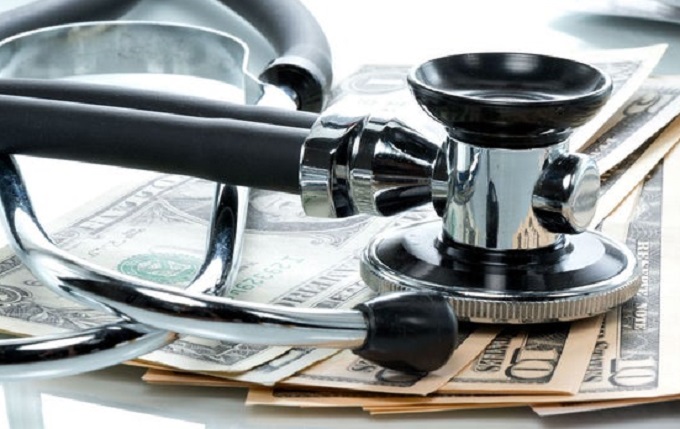Even for those with insurance, surprise bills for things not covered can add up fast.
WASHINGTON D.C. (New York Times) – Donald Trump spent three days in the hospital. He arrived and left by helicopter. He received multiple coronavirus tests, oxygen, steroids, and experimental antibody treatment.
For someone who isn’t president, that would cost more than $100,000 in the American health system.
Patients could face significant surprise bills and medical debt even after health insurance paid its share. The most significant financial risks would come not from the hospital stay, but the services provided elsewhere, including helicopter transit and repeated coronavirus testing.
Trump has praised the high quality of care he received at Walter Reed National Military Medical Center and has played down the virus’s risk. “Don’t be afraid of Covid,” Trump tweeted on Monday, before returning to the White House. “Don’t let it dominate your life.”
Across the country, patients have struggled with both the long-term health and financial effects of contracting coronavirus.
Nearly half a million have been hospitalized. Routine tests can result in thousands of dollars in uncovered charges; hospitalized patients have received bills upward of $400,000.
However, Trump did not have to worry about his care costs, which are covered by the federal government. Most Americans, including many who carry health coverage, worry about receiving the medical care they cannot afford.
For some Americans, the bills could start mounting with frequent tests. Insurers are generally required to pay for those tests when physicians order them, but not when employers do.
The Trump administration made that clear in June when it issued guidance stating that insurers do not have to pay for “testing conducted to screen for general workplace health and safety.” Instead, patients need to pay for that type of testing themselves.
Some might get free tests at public sites, and some employers may voluntarily cover the costs. Others could face significant medical debt from tests delivered at hospitals or urgent care centers.
Covid tests can be expensive. Although they typically cost $100, one emergency room in Texas has charged as much as $6,408 for a drive-through test. About 2.4 percent of coronavirus tests billed to insurers leave the patient responsible for some portion of payment, according to the health data firm Castlight. With 108 million tests performed in the United States, that could amount to millions of tests that leave patients responsible for some cost share.
The bills for the typical American would continue at the hospital, with the routine monitoring that any patient would receive and the drugs provided in the course of care.
The Cost of Care
Coronavirus Tests Are Supposed to Be Free. The Surprise Bills Come Anyway.
Coronavirus Test $1,980.
Remdesivir, a new coronavirus treatment created by Gilead, costs $3,120 when purchased by private insurers and $2,340 with public programs like Medicare and Medicaid.
Trump also received an experimental antibody treatment from Regeneron. It’s currently available to clinical trial participants or those granted a “compassionate use” exemption. In either situation, the drug would typically be provided to the patient at no charge. This will most likely change, however, when the treatment finishes trials and hits the commercial market. These types of drugs are hard to manufacture, and other monoclonal antibodies cost thousands of dollars.
According to a claims database, FAIR Health, the median charge for a coronavirus hospitalization for a patient over 60 is $61,912.
For insured patients, that price would typically be negotiated lower by their health plan. FAIR Health estimates that the median amount paid is $31,575. That amount varies significantly from one patient to another.
In the FAIR Health data on coronavirus patients over 60, a quarter face charges less than $26,821 for their hospital stay. Another quarter face charges higher than $193,149, in part because of longer stays.
Uninsured patients, however, could be stuck with the entire hospital charges and not receive any discounts. While the Trump administration set up a fund to cover coronavirus testing and treatment costs for the uninsured, The Times has reported that some Americans without health insurance have received large bills for their hospital stays.
The biggest billing risk for a patient receiving treatment similar to Trump’s would probably come from helicopter rides to the hospital.
Air ambulances are expensive and often not in major health insurance plans’ networks. The median charge for an air ambulance is $38,770, according to a study in the journal Health Affairs published this year. When the helicopter trip is out of network — as about three-quarters of them are — patients are left with a median charge of $21,698 after the insurance payout.
Taking two helicopter rides, as Trump did, could plausibly result in more than $40,000 in medical debt for patients without access to their aircraft (though, of course most people do not leave the hospital by helicopter).
A coronavirus hospitalization’s financial consequences could be long-lasting if a new Supreme Court challenge to the Affordable Care Act is successful. That case argues that Obamacare is unconstitutional, including the health law’s protections for pre-existing conditions. The administration filed a brief in June supporting the challenge.
The Supreme Court hears that case on Nov. 10. If the challenge succeeds, Covid-19 could join a long list of pre-existing conditions that would leave patients facing higher premiums or denials of coverage. In that case, coronavirus survivors could face a future in which their hospital stays increase their health costs for years to come.


